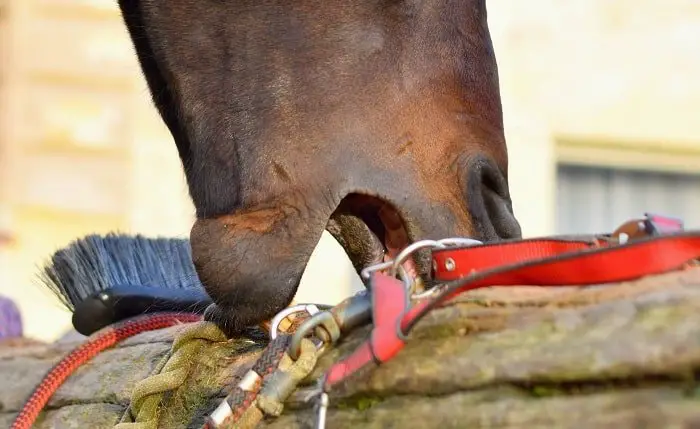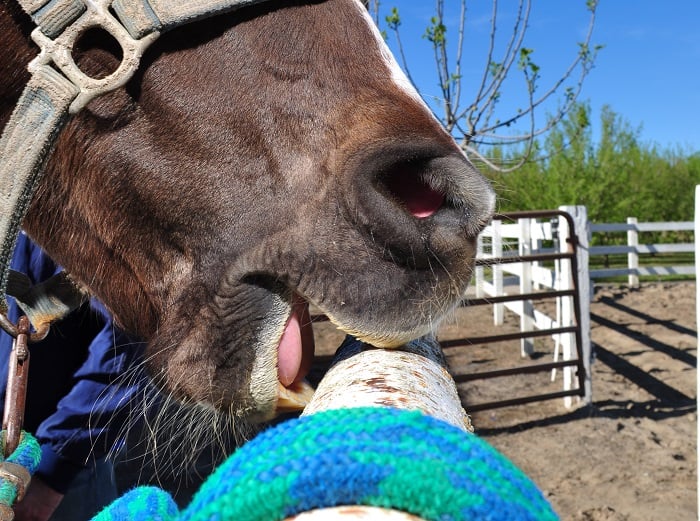Last Updated on November 27, 2021
Ever try to buy a horse that is listed as a “cribber?” Ever owned a horse that had the habit of cribbing? Then you know how serious of an issue it can be! Horse cribbing is not only irritating to horses and people surrounded by it, but it can also be detrimental to a horse’s health.
But why do some horses crib, and not others? There are many factors that can cause a horse to crib, and it is often different from case to case. Sometimes cribbing is learned, sometimes it is developed.
And, what can be done to stop cribbing or to prevent a horse from starting to crib? All of these things and more, I will be discussing in this article.
What is cribbing, why do horses crib, how can you prevent a horse from starting to crib, and how can you stop a horse that has already begun to crib.
What is Cribbing in Horses?
Cribbing is a behavior horses develop where they bite down on anything in their grasp and pull back, arching their necks and sucking in air. This is typically accompanied by a grunting noise or a deep guttural sound.
Cribbing is considered a behavioral disorder in horses, and it must be disclosed to any potential buyers or leasers of the horse as a disclaimer. Cribbing can make horses very unappealing, and it can also have negative impacts on their health.
Why Do Horses Crib?
Some say cribbing is a learned behavior, some say it is a developed behavior, but really, it varies from situation to situation.
Cribbing has never been recorded in a wild horse, which leads equine experts to believe that it is developed by situations only encountered by horses in captivity. Equine experts agree that these situations include lack of space, lack of activity, and general discomfort.
In other words, horses crib because they are bored, claustrophobic, in pain, or in some other way discomforted. It is a negative reaction to circumstances created by captivity, and lack of attention to a horse’s behavioral and mental responses to captivity.
Focusing on “pain” or physical discomfort as being a cause of cribbing, the physical issue most commonly associated with cribbing is gastric ulcers or similar issues in a horse’s digestive tract. A horse cribs to produce saliva, which then moves to the stomach and helps to buffer whatever pain a horse may be feeling.
Cribbing also slows the horse’s heart rate, lowers cortisol (a hormone that can cause stress in horses), and releases endorphins. All of these factors can contribute to a lower stress level in horses, whether they are feeling stress due to lack of space, boredom, pain, etc.
It is highly debated as to whether or not cribbing can be a learned behavior. Some equine experts believe that a horse can learn to crib by watching another horse crib. An argument supporting cribbing as a learned behavior is that cribbing most commonly begins in horses at age 2 or 3.
This is extremely young for horses to have felt extreme discomfort, claustrophobia, or other symptoms that could cause cribbing. It is then concluded that they have learned it from watching other, older horses do it.
But other equine experts are sure that this isn’t possible, and that horses don’t have the cognitive abilities to learn a behavior like cribbing from watching other horses’ behaviors.
Preventing Horse Cribbing
If cribbing is something horses develop as a result of captivity, then what can we, their captors, do to prevent it? There are two primary ways we can prevent cribbing from the beginning: sufficient turn-out time and a forage-based diet.
Both of these things are what a horse would naturally have in the wild; a grass (one type of forage) based diet and no limited space or time outdoors. More often than not, horses in captivity don’t live outside 24-7.
Because of this, horses can become stressed out or claustrophobic due to not being able to move. This itself can cause cribbing, or it can cause ulcers, which in turn can cause cribbing.
Bottom line- make sure your horse is turned out. Horses don’t necessarily need to be turned out every day of their lives (inclement weather will often prohibit turnout at many show barns). But, they should be getting outside whenever possible.
Providing a horse with a forage-based diet can also prevent a horse from beginning to crib. The two primary forages are grass and hay. If a horse gets turned out for a significant time every day, their diet will most likely be grass-based.
In climates and locations where the grass is not available, grass can be substituted with hay. It is also viable for a mixture of the two forages to be used.
For example, where I live, my horse has access to grass from April through November. But, during our winter, snow, and ice covers up the grass; during these months, my horse is fed more hay than he is when the grass is available. But, when grass is available, he still has regular access to hay, should he choose to eat it.
So long as your horse has regular access to either grass or hay, a forage-based diet has been accomplished.
Stopping Horse Cribbing
Once horses begin cribbing, it is very, very difficult to get them to stop. There are two popular recommendations that can help but are not foolproof. These are getting your horse checked and treated for ulcers and using a cribbing collar.
As stated previously, ulcers are frequently a cause for cribbing. Get rid of the ulcers, and you may get rid of the cribbing, though it is not a guarantee. Diagnosing a horse with ulcers takes a vet performing a scope test, which can be expensive.
Treating ulcers can also be expensive, though the medicine can be purchased “over the counter” and does not require a prescription. Treating a diagnosed horse for ulcers can help with numerous problems, outside of just cribbing.
Horses can also wear cribbing collars when they are in their stalls. Cribbing collars don’t prevent a horse from cribbing, and they don’t cause a horse pain, but they do make it less comfortable for a horse to crib.
Most horses start cribbing again as soon as the collar is off, and some continue cribbing while it is on. But, cribbing collars can be useful in preventing damages to the inside of a cribbing horse’s stall.
Conclusion
Cribbing can be caused by many different factors. It can be extremely frustrating to deal with, and extremely annoying to be around. Cribbing is hard to shake once it begins, but steps can be taken to prevent it from starting.
I hope this article has helped you learn about why horses crib, and what you can do about it. If so, please share this article, and share with us your experiences dealing with cribbing!
FAQs
What causes a horse to start cribbing?
Cribbing is a behaviour that involves a horse grasping a solid object with its incisor teeth, arching its neck, and sucking air into the cribbing musculature of the chest. This may be followed by swallowing air as well as expelling it from the nostrils. It typically occurs during or following periods of stress.
Some possible reasons a horse cribs:
-is a natural behaviour to some horses, and may be a response to stress or anxiety
-horses have been known to crib when bored
-may also crib due to ulcers from gastric pain
-horses can crib if they are being fed an incorrect diet, which has an improper balance of nutrients, or because they are deficient in certain minerals
To help stop cribbing, try changing the diet to see if this helps. If it does not, then you can turn to other methods such as cribbing collars.
Is cribbing harmful to horses?
Cribbing is not harmful to horses. It is actually a stress-relieving behaviour. It is very similar to a child sucking their thumb. However, cribbing could cause other problems if it becomes obsessive.
For example, cribbing could lead to worsened gastric ulcers due to the stomach acids that are sometimes regurgitated when the horse cribs and expels air. It could also potentially cause colic if the cribbing is done in a series of motions that pull on the stomach. In addition, cribbing could lead to weight loss and muscle atrophy from not allowing normal feed intake.
If any of these problems occur, you should consult a veterinarian immediately.
Can horses pick up cribbing from other horses?
Yes, cribbing can also be learned from other horses in the same stable. This is called contagious cribbing, and it is more common in stables with a high level of cribbing present. It can be broken up by changing the environment of the stable, which may lower stress levels in horses.
Cribbing can also become habitual if continued. This is especially true if it begins at a young age. If it becomes habitual, then cribbing collars may be needed to prevent it.
Are cribbing collars cruel?
Cribbing collars are causing unpleasant pressure on the horse's throat when cribbing and in that way preventing the horse from doing so. It is possible for cribbing collars to constrict the trachea, but only when they are used incorrectly. It is important to make sure these cribbing collars are fitted properly and do not cause pain, otherwise they will only exacerbate the behaviour.
However, cribbing collars are not recommended unless cribbing is creating serious problems for the horse. It would be best to try changing the horses' diet or environment before cribbing collars are used. It is also important to remember that cribbing is natural and may not need to be fully curtailed.
Is cribbing genetic?
Cribbing is thought to be genetic because cribbers are more likely to have cribbing offspring. Also, cribbing occurs in some breeds more frequently than in others. For example this behaviour is more common in leaner horses, like Arabians.
But cribbing can as well be learned from other horses. This means cribbing is partly genetic and partly learned.
As already mentioned, cribbing can also develop due to learning or environment. A horse will learn cribbing from other horses and possibly become a habitual cribber as well as begin to associate cribbing with food. This may occur if cribbing is associated with certain feed times or if the horse is cribbing to get attention.
Therefore, although cribbing has genetic components it does not mean that it cannot be prevented or reduced by changing the environment or diet of cribbing horses.
Michael Dehaan is a passionate horse owner, horse rider, and lover of all things equine. He has been around horses since he was a child, and has grown to become an expert in the field. He has owned and ridden a variety of horses of different breeds, and has trained many to compete in shows and competitions. He is an experienced horseman, having worked with and competed many horses, including his own. He is an active member of the equestrian community, participating in events and teaching riding lessons.

